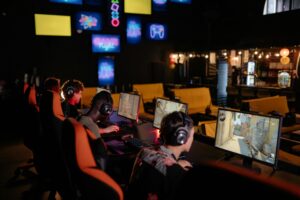The Gaming Blog

LGBTQ+ Representation in Modern Video Games
A New Era of Inclusive Gaming
Gaming reflects society, from early pixelated adventures to today’s immersive stories. For a long time, video games have not shown the diversity of their players. For years, LGBTQ+ gamers saw little to no representation on screen. When they did, it was often in the form of stereotypes or token characters.
However, times are changing.
The gaming industry is starting to focus on diversity. This shift comes as talks about identity, inclusion, and representation grow worldwide. More developers and publishers see the value in inclusive storytelling. Many new games now showcase LGBTQ+ characters, stories, and themes.
In this blog post, we’ll look at how LGBTQ+ representation in video games has changed. We’ll discuss why it’s important, who is making a difference, and what still needs improvement. We’ll highlight key titles, analyse industry trends, and explore the social and economic effects of more inclusive gaming.
Whether you’re a gamer, developer, or simply an advocate for equality, this deep dive will shed light on the progress made and the path ahead.

The Evolution of LGBTQ+ Representation in Gaming
From Silence to Stereotypes (1980s-2000s)
During the early decades of gaming, LGBTQ+ characters were either invisible or reduced to crude stereotypes. Games often targeted heterosexual male players. Anything outside that focus was ignored or made fun of.
- Birdo, from Super Mario Bros. 2 (1988), is one of the earliest examples. Her gender identity was inconsistently referenced and often misunderstood.
- In Leisure Suit Larry, LGBTQ+ characters were frequently the butt of jokes, reinforcing harmful tropes.
Breaking Ground: The Mid-2000s to 2010s
A new wave of developers began to challenge the status quo. Games like:
- The Sims series allowed for same-sex relationships from the early 2000s.
- Mass Effect and Dragon Age introduced optional same-sex romances, albeit with limitations.
These efforts weren’t perfect, but they set the stage for the future. They created a gaming world where LGBTQ+ stories could be told with real depth and authenticity.
Modern LGBTQ+ Representation: Key Games & Milestones
Indie Games Leading the Way
Independent developers have played a massive role in driving LGBTQ+ inclusion. Indie games, free from corporate pressure, often tell personal stories. They aim for authentic representation.
- Gone Home (2013): A narrative exploration game that centres on a teenage girl discovering her sister’s secret relationship.
- Night in the Woods (2017): Features several LGBTQ+ characters and themes of identity, belonging, and mental health.
- If Found… (2020): A visual novel that explores the life of a trans woman in rural Ireland.
These games have been praised for their emotional depth and sincere storytelling.
AAA Titles Embracing Diversity
Major studios are catching up, incorporating LGBTQ+ representation in more significant ways:
- The Last of Us Part II: Features a lesbian protagonist, Ellie, and her complex relationship with Dina.
- Cyberpunk 2077: Offers gender customisation and multiple LGBTQ+ romance options.
- Life is Strange: True Colors: Allows players to pursue same-sex relationships and explore bisexual identity.
These games mark a shift in mainstream gaming, acknowledging that LGBTQ+ stories deserve a central place.

Why Representation Matters in Gaming
Visibility and Validation
Seeing oneself reflected in media can be life-changing. For LGBTQ+ players, inclusive games provide:
- Affirmation: Representation validates identity and offers a sense of belonging.
- Community: Shared experiences foster connection among gamers.
- Inspiration: Inclusive characters can inspire players to embrace their true selves.
Challenging Stereotypes and Fostering Empathy
Diverse stories humanise experiences and challenge outdated notions. When players walk in the shoes of LGBTQ+ characters, they gain:
- Empathy for marginalised groups.
- Awareness of issues like discrimination, identity struggles, and coming out.
Market Demand and Business Benefits
Studies show a growing demand for diversity:
- A 2022 GLAAD report revealed that 20% of Gen Z gamers identify as LGBTQ+.
- Games with inclusive content often enjoy critical acclaim and commercial success.
Inclusion isn’t just the right thing to do—it makes sound business sense.
Industry Voices: Developers and Advocates Pushing Change
Notable LGBTQ+ Game Developers
Representation starts behind the scenes. Prominent LGBTQ+ developers are influencing the industry from within:
- Robert Yang: Known for provocative, queer-themed games like Rinse and Repeat and The Tearoom.
- Brenda Romero: A vocal advocate for inclusivity in design and storytelling.
These voices are crucial in shaping a more equitable gaming landscape.
Gaming Studios Setting an Example
Some studios are leading by example when it comes to inclusive policies and content:
- Dontnod Entertainment: Known for Life is Strange, they consistently centre marginalised identities.
- Naughty Dog: With The Last of Us, they showed that AAA games can feature queer leads without compromising narrative or success.
Challenges and Criticisms in LGBTQ+ Gaming Representation
Tokenism and Surface-Level Inclusion
While inclusion is increasing, not all representation is created equal. Common pitfalls include:
- Token characters with no depth or relevance.
- Representation added only to check a box or avoid backlash.
Authenticity must remain a top priority.
Backlash from Audiences
Despite progress, some players respond negatively to LGBTQ+ content:
- Review-bombing of inclusive titles.
- Online harassment of developers and streamers.
This highlights the need for ongoing education and community moderation.
Regional Censorship
In some countries, LGBTQ+ content is restricted or banned entirely. This limits access to inclusive games and stifles creative freedom.

The Future of Inclusive Gaming
Emerging Trends in LGBTQ+ Representation
Looking ahead, we can expect:
- More trans and non-binary characters with nuanced stories.
- Emphasise intersectionality by showcasing the unique experiences of LGBTQ+ people of colour, disabled gamers, and others.
- Increased player agency in shaping queer narratives.
Role of Education and Community Platforms
Gaming communities, forums, and education play a critical role in:
- Promoting respectful dialogue.
- Offering resources on inclusive game design.
- Creating safe spaces for LGBTQ+ gamers to connect and thrive.
Opportunities for Collaboration
Industry collaboration is essential to lasting progress. This includes:
- Partnering with LGBTQ+ advocacy groups.
- Consulting sensitivity readers and community advisors during game development.
- Encouraging diverse hiring and leadership within studios.
Conclusion: Embracing the Power of Inclusive Play
The rise of LGBTQ+ representation in modern video games is more than a trend. It’s a movement reshaping the gaming world for the better. Gaming is a powerful space for connection and exploration. Indie developers share personal stories, while AAA studios embrace diversity. This shift offers validation for many.
Yet, the journey is far from over. While progress is undeniable, challenges persist—from surface-level portrayals to active backlash. Keep advocating, engage with the community, and share real stories from LGBTQ+ voices.
For gamers, inclusive games offer more than entertainment. They act as mirrors and windows. They reflect our identities and values. They also offer views into experiences different from ours. This dual power fosters empathy, challenges norms, and drives cultural change.
Developers must embrace bold creativity, inclusive design, and strong partnerships with marginalised communities. The rewards? Deeper player connection, broader market appeal, and a legacy of positive impact.
As the industry evolves, let’s champion games that reflect the true diversity of players worldwide. Let’s support creators who dare to push boundaries. Let’s keep building a gaming culture where everyone is seen, heard, and celebrated.
Ready to explore more inclusive titles? Share your favourite LGBTQ+ games or developers in the comments — let’s celebrate the voices shaping the future of play.









